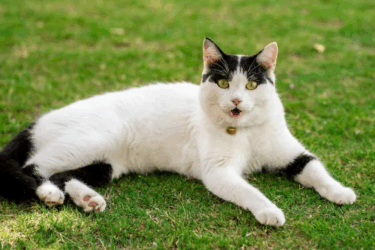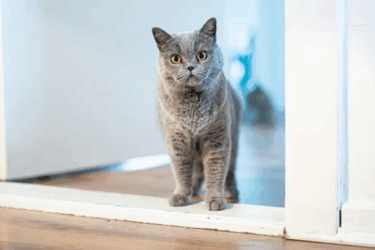Do you ever wonder what goes on in your cat’s mind when they’re staring at you from the windowsill? Keep reading, because cats think and feel a lot more than you might expect!

On this page, you’ll learn:
- Whether cats can think
- How a cat thinks
- What cats think
- What cats think of humans (and their owner)
- What emotions a cat has
1. Can Cats Think?
Cats can absolutely think! They are known for being independent and quirky animals that love to sleep, but don’t be fooled: underneath that cute exterior is a pretty smart brain. Research shows that a cat’s brain can make decisions, plan things, and store memories.
Cats Learn Through Associations
Cats are highly intelligent. They learn quickly by gaining experiences and making associations and connections. And that’s typical cat behavior. Here are a few examples:
- You open a cupboard door → your cat thinks of cat treats
- The front door opens → your cat runs to the door to greet you
- Your alarm clock goes off → your cat knows it’s time to be fed
Yvon Sweere, a cat behavior therapist, says: “Cats understand connections incredibly quickly and remember them. For example, they know exactly where the treats are, even if you try to outsmart them by putting them in a different spot.
And although cats are most likely not thinking about their future or worrying about what others think (they certainly don’t waste time on that), they can think strategically. For example, cats can solve puzzles. The fun part is that there has to be something in it for them. And that’s often a tasty snack.
Cats Learn by Observing
Cats can also learn by watching. They find it very interesting to discover how you open a door and will try to mimic it (if it’s useful to them). You can find videos online of cats turning on faucets or learning how to turn the lights on or off.
Cats Learn by Remembering
Cats also have excellent memory. Things that happened months ago are usually well remembered – especially if the memory makes them think of something pleasant or unpleasant. Their memory primarily works based on the emotion they felt at the time: it was enjoyable or it was not. If cats like something (positive), they learn quickly and repeat it. If they didn’t enjoy something (negative), they often avoid it later. For example, a visit to the vet – once is often enough for a lasting trauma. So yes, cats can definitely think!
Did you know that cats really live in the moment? They don’t dwell on yesterday and don’t worry about tomorrow. Only what happens now matters. When you see a cat enjoying a sunbeam or scratching away at a cat tree, they are fully present in the moment – mindful, without yoga or meditation. We humans could learn a lot from that!

2. How Does a Cat Think?
Cats primarily think in images, sounds, smells, and feelings. This explains why they are so good at remembering places where they’ve found something tasty – even if it was weeks ago. And why they trust certain people (or not). The way cats think is mostly focused on survival and – not surprisingly – comfort.
Routines and Habits
Another characteristic of a cat’s brain is that it is sensitive to routines and patterns. If you suddenly change the location of their food bowl, your cat will first be confused. And not because they can’t find the food bowl anymore, but because their internal map no longer aligns. Cats build a mental image of their familiar environment, and anything that doesn’t fit into that image causes confusion – and sometimes even stress. But cats are flexible and eventually adjust their map to the new situation.
The way cats think is a clever combination of instinct, experience, and adaptability. They don’t think the way humans do, but in their own clever way. What exactly goes on in their minds, we may never fully know. But one thing is certain: cats have a very smart and sensitive brain.
3. What Do Cats Think About?
Cats aren’t busy planning their retirement or analyzing their childhood traumas. But what do cats usually think about? In short, cats tend to think about 4 things:
- Food
- Sleeping
- Hunting
- Cuddling (if they feel like it)

4. What Do Cats Think of People (And Their Owner)?
Cats don’t see us as their kind, but they do form a strong bond with us. They don’t view us as family, but they do see us as “okay” and recognize our voice. Cats know exactly who their personal “can opener” is, who always gives them treats, and who they should avoid disturbing. In fact, cats differentiate between the people living in their house and respond to each person in a different way.
So, what do cats think of people? We are an important part of their social circle. They bond with us in their own way. Some cats prefer to go their own way, while others like to curl up next to you on the couch. If your cat does this, you’ve passed the ultimate cat test, and you’ll know right away if your cat likes you (source: New Scientist).
5. What Emotions Do Cats Have?
If you think cats are cool and distant, you’re underestimating these lovely creatures. Cats actually feel a lot, and they do so in a way that closely resembles how we humans experience emotions. Cats experience emotions daily, such as:
- Fear
- Joy
- Frustration
- Irritation
- Anger
- Boredom
- Curiosity
- Affection (love)
- Satisfaction
Cats’ emotions are also strongly linked to their (safe) environment. They love predictability and can quickly become unbalanced when a lot changes. A new couch? Tension. Busy kids visiting? Stress. A renovation? Terrible!
Is your cat often anxious? You can make them happy with a tall cat tree, as they can not only retreat to it for safety but also enjoy scratching it. And every cat relaxes from that!
Cats are creatures of habit, and how they feel is greatly influenced by a familiar and calm environment. If that peace and routine are disrupted, you’ll notice it in your cat: they may hide, groom excessively, and become irritable or incontinent. A cat will show you that they don’t feel well this way (source: Cat Knowledge Center).

But cats can also play, relax, and enjoy life! If your cat is lying flat in the sun, playing enthusiastically with a toy, or kneading a cushion or blanket, you’ll see pure contentment in your cat. It’s important for us as cat owners to stimulate these positive emotions. And you do that by playing with your cat daily, cuddling, and giving them attention, care, or rest when they need it.
Scientists are still unsure whether cats can experience more complex emotions, like jealousy or guilt, as we do. But they now know that cats feel and experience much more than we ever thought. So, if your cat behaves differently, don’t just look at what they’re doing, but try to understand how they’re feeling. When you understand their behavior, cats say a lot!
Want to know how cats communicate with us? Check out our Mini-Course on Cat Language!
Cats think, feel, and experience their world in their own unique way. They live in the moment, follow their instincts, and are emotionally much smarter than we often think. Cats don’t worry, they feel, react, and move on. This not only makes them very interesting but also creatures we can learn from
Disclaimer: Petrebels is not a veterinarian or behavior expert; all content, information, and tips on this page are meant to inspire and are for informational purposes. If your cat has symptoms or health concerns and you’re unsure about their health, always visit the vet or a behavior expert.


